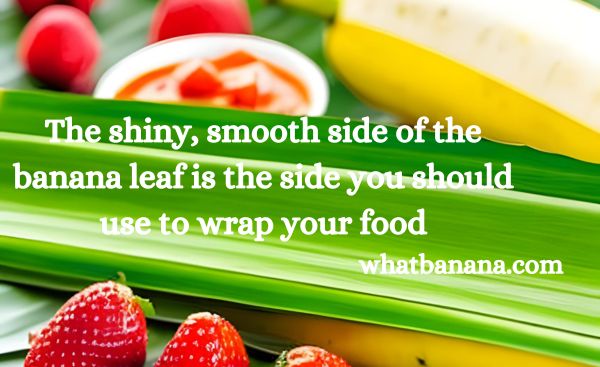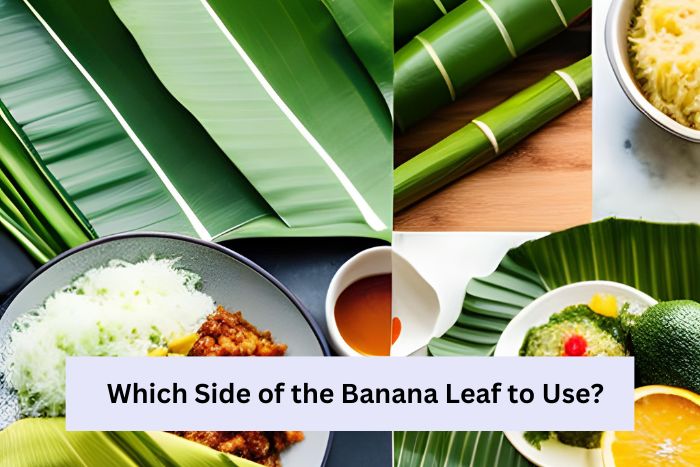I love using banana leaves in my cooking.
They add an earthy, aromatic flavor to my dishes and make for a beautiful presentation.
However, when it comes to using banana leaves, one question that often comes up is which side to use.
A Guide to Traditional Serving Etiquette
The shiny, smooth side of the banana leaf is the side you should use to wrap your food. This is because the shiny side is the natural protective layer of the leaf, which helps to keep the moisture and flavor of the food inside while also protecting it from the porous, rough side of the leaf.
They are also used as a wrap for tamales and other finger foods.
Banana leaves are an inexpensive and eco-friendly alternative to parchment paper, aluminum foil, or plastic bags, and they also offer health benefits such as antioxidants and polyphenols.
However, it’s important to properly rinse and store banana leaves to avoid tears and maintain their freshness.
| 🍌💚 Top 5 Benefits of Cooking with Banana Leaves 💚🍌 | |
|---|---|
| 1 | Enhances Flavor: Banana leaves have a subtle sweet flavor which gets infused into the food, enhancing its taste. |
| 2 | Eco-friendly: Banana leaves are a natural, renewable resource, offering a green alternative to aluminum foil or plastic wrap. |
| 3 | Health Benefits: Banana leaves are packed with plant-based compounds like polyphenols, which are beneficial for health. |
| 4 | Heat Resistance: Banana leaves are great for cooking because they can resist high temperatures without melting or breaking. |
| 5 | Improves Presentation: Cooking with banana leaves adds a unique aesthetic to your dishes, creating a natural and exotic presentation. |
| 🌐 Check out more on whatbanana.com 🍌 | |
Why Use Banana Leaves?
As a keen cook, I love using banana leaves in my recipes.
They are versatile and flavorful, and add a touch of elegance to any dish.
In this section, I will discuss the culinary uses and health benefits of banana leaves.
Culinary Uses
Banana leaves have been used for centuries in many cuisines around the world.
In Southeast Asia, they are commonly used to wrap rice, fish, meat, and tamales for steaming, baking, or grilling.
The leaves are also used as a lining for plates or party platters, adding a beautiful touch to finger foods and side dishes.
One of the best things about banana leaves is their flavor.
They have a slightly earthy and aromatic smell that adds a unique flavor to any dish.
The leaves are also porous, which allows them to retain moisture and flavor.
When used for grilling, the leaves protect the food from the direct flame, resulting in a subtler and smoky flavor.

Health Benefits
Aside from their culinary uses, banana leaves also offer many health benefits.
They contain antioxidants and polyphenols that are beneficial to our health.
These compounds help fight inflammation, boost our immune system, and protect our cells from damage.
To use banana leaves for cooking, rinse them under cold water and dry them with a clean towel.
If you are using frozen leaves, thaw them at room temperature before using them.
To wrap food in banana leaves, cut the leaves into the desired size and shape and use toothpicks or string to secure them.
You can also use banana leaves for cooking en papillote, a French technique where food is cooked in a parchment paper or banana leaf pouch.
Inexpensive and widely available in Asian supermarkets, banana leaves are a great alternative to aluminum foil or plastic wrap.
They are also eco-friendly and biodegradable, making them a perfect choice for those who are environmentally conscious.
In conclusion, banana leaves are a versatile and healthy ingredient that adds a unique flavor and aroma to any dish.
Whether you are cooking Caribbean-spiced fish wrapped in banana leaves or grilled shrimp in a banana-leaf pouch, banana leaves are a great addition to any recipe.
So next time you’re at the market, grab a few banana leaves and experiment with different dishes.
You won’t be disappointed!

How to Choose and Prepare Banana Leaves
As someone who loves cooking with banana leaves, I’ve learned a few things about how to choose and prepare them to get the best results.
Here are my tips for buying, storing, rinsing, and cleaning banana leaves.
Buying Banana Leaves
You can find banana leaves at most Asian supermarkets or Latin markets.
Look for fresh, bright green leaves that are not too dry or too wet.
If you can’t find fresh leaves, frozen banana leaves are a good alternative.
They are usually sold in plastic bags and can be stored in the freezer for up to six months.
Storing Banana Leaves
Fresh banana leaves should be stored in a cool, dry place, away from direct sunlight.
You can wrap them in a damp paper towel and place them in a plastic bag to keep them fresh for a few days.
Frozen banana leaves should be thawed in the refrigerator before use.
Rinsing and Cleaning Banana Leaves
Before using banana leaves, rinse them thoroughly with cold water to remove any dirt or debris.
Then wipe them dry with a clean towel.
If the leaves are too large, you can cut them into smaller pieces.
To soften the leaves, you can pass them over an open flame or steam them for a few minutes.
Science Behind Eating on a Banana Leaf
Key Takeaways
- Boiled banana leaves are a versatile and healthy ingredient that adds an earthy, aromatic flavor to dishes such as Caribbean-spiced fish or grilled shrimp wrapped in a banana-leaf pouch.
- The shiny, smooth side of the banana leaf should be used to wrap food, as it acts as a natural protective layer, retaining moisture and flavor while shielding the food from the rough side of the leaf.
- Banana leaves offer numerous health benefits, including antioxidants and polyphenols that fight inflammation, boost the immune system, and protect cells from damage, making them an excellent addition to a natural remedy toolkit.
- When using banana leaves for cooking, it’s important to properly rinse them to remove dirt and debris, cut them into desired sizes, and soften them by briefly passing them over an open flame or steaming.
- By using banana leaves as a sustainable and biodegradable alternative to parchment paper or plastic wrap, you can elevate your culinary creations while contributing to environmental consciousness.
Discover the versatile uses of banana leaves, from enhancing flavors in cooking to providing health benefits, and make them a staple in your kitchen.
Ready to elevate your culinary creations and explore the health benefits of banana leaves?
Start incorporating them into your recipes and experience the unique flavors and eco-friendly advantages they offer.
